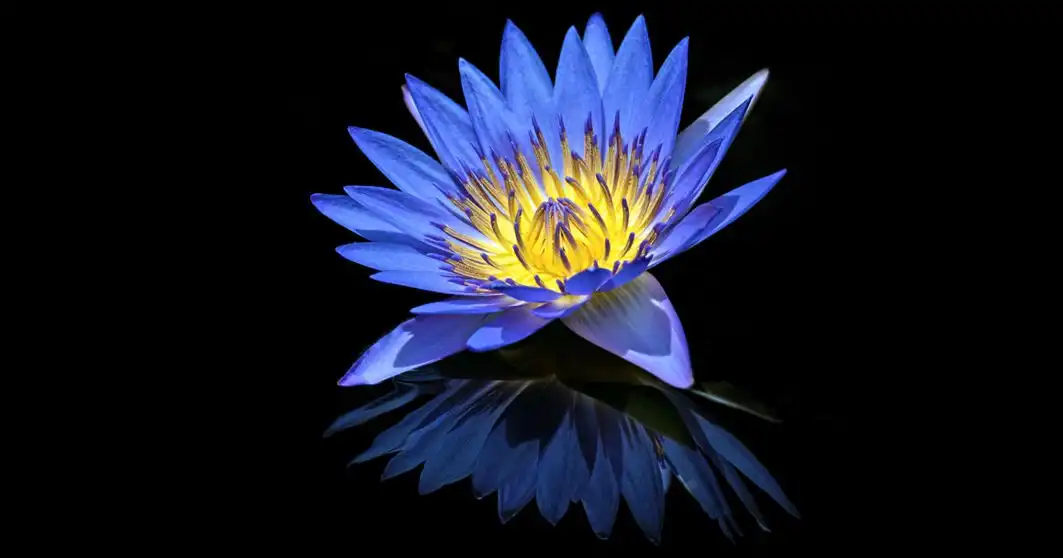
Introduction
Although Nymphaea Caerulea is commonly referred to as a blue lotus, it is actually a waterlily.
- Family: Nymphaeaceae
- Genus: Nymphaea
- Species: Caerulea, Nouchaliivar. Var. Caerulea
- Common Names: Egyptian Blue Lotus, Blue Water Lily, Sacred Lily of the Nile
The Blue Lotus (Nymphaea caerulea) is actually a water lily native to Egypt, where it was used in art, religious rituals, herbal medicine, perfumes and teas.
Symbolism and Cultural Significance
The Blue Lotus (Nymphaea caerulea) has ancient origins rooted primarily in Egyptian civilization, where it was revered for its symbolic and medicinal properties. Depicted in tomb paintings, temple carvings, and hieroglyphs, the flower was often offered to the gods and associated with the sun god Ra and Osiris, as it symbolized rebirth and regeneration due to it’s daily blooming cycle. The people believed it induced relaxation and heightened spiritual awareness. Over time, the blue lotus influenced many cultures’ art, medicine, and religious practices. In Buddhism, the lotus symbolizes spiritual enlightenment, purity, and the ability to rise above suffering. It is associated with divine beauty, creation, and prosperity, symbolizing the soul’s journey toward spiritual awakening in Hinduism. Ancient scriptures like the Rigveda celebrate the lotus.
Identification and Cultivation
Nymphaea Caerulea flowers have vibrant blue or bluish-white petals, a sweet fragrance and grow to be between four and six inches in diameter. The large water-repellent leaves or lily pads can grow up to 16 inches in diameter. They are green on top and purple on the bottom, and they float on the surface of the water.
Thriving in warm, sunlit conditions, the blue lotus flourishes in shallow waters, requiring regular pruning and harvesting to maintain its beauty and health.
Modern Use
The blue lotus is experiencing a renaissance, being celebrated in art, admired for its fragrance, and researched for its potential medicinal qualities.
Herbal Medicine
As a natural remedy, the blue lotus is sought after for its ability to possibly alleviate stress, anxiety, enrich sexual health and increase libido, and promote a sense of well-being.
More scientific study and research is needed.
Fragrance and Aromatherapy
The soothing aroma of blue lotus makes it a favorite in aromatherapy, lending its fragrance to candles, oils, and perfumes.
Skin Care
Packed with antioxidants, blue lotus is a boon for skincare, offering hydrating and soothing effects for a variety of skin conditions.
Teas and Infusions
Blue lotus tea is widely used as a calming bedtime beverage. In many cultures, it is also considered a health drink.
Smoking
The dried petals and stamens of the flowers and leaves of the blue lotus are smoked or vaporized for relaxation.
Ceremonial Use
Still significant in spiritual practices, including smudging, the blue lotus symbolizes a deep ceremonial reverence for nature and the divine.

Thank you for this informative put up on Nymphaea Caerulea, the Sacred Blue Lotus. It’s captivating to analyze about the historic and cultural importance of this historic plant. The vivid description of its use in rituals and as a herbal relaxant is intriguing. I’d love to hear extra about cutting-edge functions and the place one would possibly supply this sacred plant today. Overall, a well-researched and charming article, shedding mild on an interesting section of historical Egyptian culture.
Thank you. That is a great suggestion. I have done some further research on the ways blue lotus is being used today and updated the article.